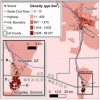Prevalence of Asthma in School Children on the Arizona-Sonora Border
- PMID: 27544711
- PMCID: PMC5222738
- DOI: 10.1016/j.jaip.2016.07.001
Prevalence of Asthma in School Children on the Arizona-Sonora Border
Abstract
Background: Mexican-born children living in the United States have a lower prevalence of asthma than other US children. Although children of Mexican descent near the Arizona (AZ)-Sonora border are genetically similar, differences in environmental exposures might result in differences in asthma prevalence across this region.
Objective: The objective of this study was to determine if the prevalence of asthma and wheeze in these children varies across the AZ-Sonora border.
Methods: The International Study of Asthma and Allergy in Children written and video questionnaires were administered to 1753 adolescents from 5 middle schools: Tucson (school A), Nogales, AZ (schools B, C), and Nogales, Sonora, Mexico (schools D, E). The prevalence of asthma and symptoms was compared, with analyses in the AZ schools limited to self-identified Mexican American students.
Results: Compared with the Sonoran reference school E, the adjusted odds ratio (OR) for asthma was significantly higher in US schools A (OR 4.89, 95% confidence interval [CI] 2.72-8.80), B (OR 3.47, 95% CI 1.88-6.42), and C (OR 4.12, 95% CI 1.78-9.60). The adjusted OR for wheeze in the past year was significantly higher in schools A (OR 2.19, 95% CI 1.20-4.01) and B (OR 2.67, 95% CI 1.42-5.01) on the written questionnaire and significantly higher in A (OR 2.13, 95% CI 1.22-3.75), B (OR 1.95, 95% CI 1.07-3.53), and Sonoran school D (OR 2.34, 95% CI 1.28-4.30) on the video questionnaire compared with school E.
Conclusions: Asthma and wheeze prevalence differed significantly between schools and was higher in the United States. Environmental factors that may account for these differences could provide insight into mechanisms of protection from asthma.
Keywords: Asthma; Bacterial Load; Environment; Mexican Americans; Socioeconomic Factors; Wheezing.
Copyright © 2016 American Academy of Allergy, Asthma & Immunology. Published by Elsevier Inc. All rights reserved.
Figures
Similar articles
-
Who gets diagnosed with asthma? Frequent wheeze among adolescents with and without a diagnosis of asthma.Pediatrics. 2003 May;111(5 Pt 1):1046-54. doi: 10.1542/peds.111.5.1046. Pediatrics. 2003. PMID: 12728087
-
Assessment of respiratory symptoms and asthma prevalence in a U.S.-Mexico border region.Arch Environ Health. 2003 Mar;58(3):156-62. doi: 10.3200/AEOH.58.3.156-162. Arch Environ Health. 2003. PMID: 14535575
-
Associations of doctor-diagnosed asthma with immigration status, age at immigration, and length of residence in the United States in a sample of Mexican American School Children in Chicago.J Asthma. 2009 Oct;46(8):796-802. J Asthma. 2009. PMID: 19863283
-
Associations of physician-diagnosed asthma with country of residence in the first year of life and other immigration-related factors: Chicago asthma school study.Ann Allergy Asthma Immunol. 2007 Sep;99(3):236-43. doi: 10.1016/S1081-1206(10)60659-X. Ann Allergy Asthma Immunol. 2007. PMID: 17910327
-
Antibiotic use in infancy and the risk of asthma in Mexican American children.J Asthma. 2015 Sep;52(7):707-14. doi: 10.3109/02770903.2015.1004338. Epub 2015 Mar 3. J Asthma. 2015. PMID: 25584659
Cited by
-
Microbiota and human allergic diseases: the company we keep.Curr Opin Immunol. 2021 Oct;72:215-220. doi: 10.1016/j.coi.2021.06.002. Epub 2021 Jun 26. Curr Opin Immunol. 2021. PMID: 34182271 Free PMC article. Review.
-
Prevalence of asthma and associated factors among male late adolescents in Tabriz, Iran.Environ Sci Pollut Res Int. 2018 Jan;25(3):2184-2193. doi: 10.1007/s11356-017-0553-6. Epub 2017 Nov 8. Environ Sci Pollut Res Int. 2018. PMID: 29116535
-
Contributions of the early-life microbiome to childhood atopy and asthma development.Semin Immunol. 2023 Sep;69:101795. doi: 10.1016/j.smim.2023.101795. Epub 2023 Jun 26. Semin Immunol. 2023. PMID: 37379671 Free PMC article. Review.
-
Microbiota, Epigenetics, and Trained Immunity. Convergent Drivers and Mediators of the Asthma Trajectory from Pregnancy to Childhood.Am J Respir Crit Care Med. 2021 Apr 1;203(7):802-808. doi: 10.1164/rccm.202010-3779PP. Am J Respir Crit Care Med. 2021. PMID: 33493428 Free PMC article. No abstract available.
-
Health conditions among farmworkers in the Southwest: An analysis of the National Agricultural Workers Survey.Front Public Health. 2022 Nov 3;10:962085. doi: 10.3389/fpubh.2022.962085. eCollection 2022. Front Public Health. 2022. PMID: 36407981 Free PMC article.
References
-
- Canino G, Koinis-Mitchell D, Ortega AN, McQuaid EL, Fritz GK, Alegría M. Asthma disparities in the prevalence, morbidity, and treatment of Latino children. Soc Sci Med. 2006;63(11):2926–2937. - PubMed
-
- Akinbami LJ, Moorman JE, Bailey C, et al. Trends in asthma prevalence, health care use, and mortality in the United States, 2001-2010. NCHS Data Brief. 2012;(94):1–8. - PubMed
-
- Leong AB, Ramsey CD, Celedón JC. The challenge of asthma in minority populations. Clin Rev Allergy Immunol. 2012;43(1-2):156–183. - PubMed
-
- Moorman JE, Zahran H, Truman BI, Molla MT, (CDC) CfDCaP Current asthma prevalence - United States, 2006-2008. MMWR Surveill Summ. 2011;60(Suppl):84–86. - PubMed
Publication types
MeSH terms
Grants and funding
LinkOut - more resources
Full Text Sources
Other Literature Sources
Medical
Molecular Biology Databases
Miscellaneous


